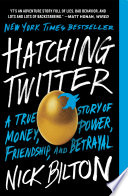

The book opens with the inception of Twitter, detailing how the idea emerged from a small group within Odeo, a podcasting company. The narrative illustrates the challenges faced by the founders, including the need for a pivot due to the rise of Apple's iTunes. It captures the initial brainstorming sessions, highlighting how Jack Dorsey and Biz Stone, along with Evan Williams, recognized the potential for a microblogging platform. The tension between the founders and the challenges of developing a new product in a competitive landscape is vividly depicted. The book emphasizes the importance of adaptability and innovation in entrepreneurship, showcasing how a simple idea can evolve into a global phenomenon. The initial struggles and triumphs lay the groundwork for understanding the dynamics of startup culture.
Continue readingThe book delves into the complex relationships among Twitter's founders, particularly focusing on Jack Dorsey, Evan Williams, Biz Stone, and later, Dick Costolo. Each founder brought unique skills and perspectives, but their differing visions led to conflicts. The narrative explores how these interpersonal dynamics influenced decision-making and the direction of the company. It illustrates the importance of leadership styles and the impact of personal relationships on business outcomes. The book provides insights into how effective communication and alignment of vision among founders can either propel a startup forward or lead to its downfall, making it a critical read for aspiring entrepreneurs.
Continue readingAs Twitter gained traction, the book highlights the various challenges associated with rapid growth. It discusses the technical hurdles the team faced in scaling the platform to accommodate millions of users. The narrative also touches on the financial pressures, user engagement issues, and the need for a sustainable business model. The authors illustrate the tension between maintaining user experience and monetization. This section serves as a cautionary tale about the pitfalls of scaling too quickly without proper infrastructure and strategy. Understanding these challenges is essential for anyone involved in startups or technology, as it reveals the complexities behind seemingly successful companies.
Continue readingThe book explores how media coverage and public perception shaped Twitter's trajectory. It discusses pivotal moments where Twitter was thrust into the spotlight, such as during major events like the Arab Spring and the 2009 Iranian elections. The authors analyze how these events showcased Twitter's potential as a tool for social change, but also how they led to scrutiny and criticism. The narrative emphasizes the dual-edged sword of media attention, illustrating how it can drive user growth while simultaneously bringing challenges related to content moderation and platform responsibility. This insight into the relationship between technology and society is crucial for understanding the broader implications of social media.
Continue readingThe book details the tumultuous leadership changes within Twitter, particularly focusing on Jack Dorsey's ousting and eventual return as CEO. The narrative highlights how different leadership styles influenced company culture and strategic direction. It examines the consequences of these changes, including shifts in company priorities, employee morale, and investor confidence. The authors provide a nuanced view of how leadership transitions can either revitalize a company or lead to instability. This section serves as a lesson on the importance of strong, consistent leadership in navigating the challenges of a growing tech company.
Continue readingA significant theme in the book is Twitter's struggle to achieve profitability. The authors discuss the various monetization strategies the company pursued, including advertising and partnerships. They illustrate the tension between growth and profitability, emphasizing how the pressure to deliver financial results can impact innovation and company culture. The narrative highlights the differing opinions among the leadership team regarding the best path forward, providing a comprehensive view of the complexities involved in managing a tech startup's financial health. This exploration of financial strategy is particularly valuable for entrepreneurs and business leaders looking to balance growth with sustainable practices.
Continue readingIn the concluding chapters, the book reflects on the legacy of Twitter, considering its impact on communication, media, and society at large. The authors discuss how Twitter has changed the way information is disseminated and consumed, as well as its role in shaping public discourse. They also touch on the ethical implications of social media, including issues related to misinformation and user privacy. This reflection provides a broader context for understanding the significance of Twitter beyond just a business success story. It encourages readers to think critically about the role of technology in society and the responsibilities that come with it.
Continue reading